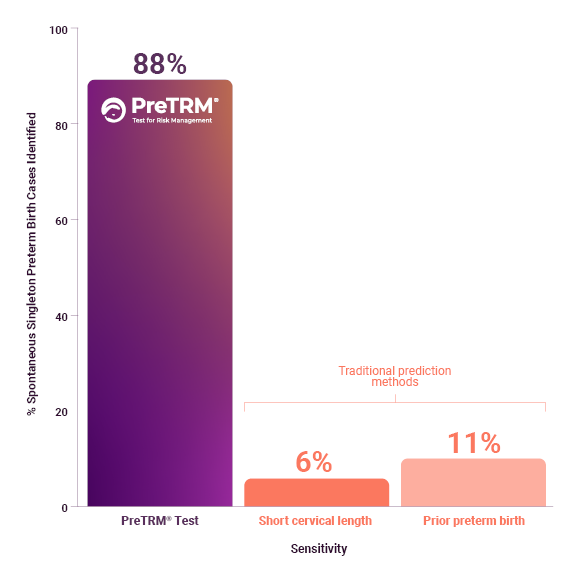One in 10 babies is born too soon
With an incidence of one in 10 pregnancies1, preterm birth is considered by many medical experts to be a public health crisis. The emotional, financial, and long-term health implications for preterm babies and their families can be overwhelming. Up until this point, ways to accurately predict the risk of a preterm delivery have been limited, with only a small percentage of high risk patients identified through clinical or demographic risk factors.

Determine your patient’s risk of spontaneous preterm birth, even if she lacks evident risk factors
The PreTRM® Test provides physicians with their patients’ risk for spontaneous premature birth in asymptomatic, singleton pregnancies.⁶ This pivotal information — provided in the form of an individual risk percentage — gives you sufficient time and vital insights to make informed treatment decisions with your patients.
The PreTRM® Test is designed to identify patients at higher risk for spontaneous preterm birth
Accurately identifying women at higher risk for spontaneous preterm delivery is a critical first step to addressing an early delivery’s health impacts. PreTRM Test integration enables you to more accurately identify and manage preterm birth risk for better outcomes.

The PreTRM test is suitable for 88% of singleton pregnant women4,5
PreTRM® Intended Use:
The PreTRM® Test for Risk Management predicts the risk of spontaneous preterm birth (before 37 weeks) in asymptomatic women (no signs or symptoms of preterm labor, with intact membranes) with a singleton pregnancy.⁶ The PreTRM Test is performed via a single blood draw between 18 and 20 6/7 weeks of gestation (126-146 days). It is not intended for use in women who have a multiple pregnancy, have a known or suspected fetal anomaly, or are on any form of progesterone therapy after the first trimester.
- Women ≥18 years old with a singleton pregnancy
- Not on heparin therapy
- No prior history of preterm birth or shortened cervix
- Asymptomatic for preterm labor
- Not on progesterone therapy after the first trimester
- No known or suspected fetal anomaly
Offer the PreTRM® Test at Your Practice
References
- Osterman, MJK, et al. Births: Final Data for 2020. Division of Vital Statistics, National Center for Health Statistics, U.S. Centers for Disease Control and Prevention. (February 2022). Available at https://www.cdc.gov/nchs/nvss/births.htm
- Iams, JD. Clinical Practice. Prevention of preterm parturition. N Engl J Med. 2014;370:254-61.
- Burchard, J., et al. Better Estimation of Spontaneous Preterm Birth Prediction Performance through Improved Gestational Age Dating. J. Clin. Med. 2022, 11, 2885. https:// doi.org/10.3390/jcm11102885
- Petrini JR, et al. Estimated effect of 17 alpha-hydroxyprogesterone caproate on preterm birth in the United States. Obstet Gynecol. 2005;105:267-72.
- Hassan SS, et al. Vaginal progesterone reduces the rate of preterm birth in women with a sonographic short cervix: a multicenter, randomized, double-blind, placebo-controlled trial. Ultrasound Obstet Gynecol. 2011;38:18-31.
- Considerations for use: The PreTRM Test for Risk Management predicts the risk of spontaneous preterm birth (before 37 weeks) in asymptomatic women (no signs or symptoms of preterm labor with intact membranes) ≥18 years old with a singleton pregnancy. The PreTRM Test is performed via a single blood draw between 18wk – 20wk/6d (126 – 146 days) gestation. It is not intended for use in women who have a multiple pregnancy, have a known or suspected fetal anomaly, or are on any form of progesterone therapy after the first trimester. If the PreTRM Test was ordered for a patient outside of intended use for this test, caution should be exercised when interpreting the personalized risk results.